CEO Application Note #13 Reliability of High Power QCW Arrays
Northrop Grumman Cutting Edge Optronics
Application Note #13
Reliability of High Power QCW
Arrays
Northrop
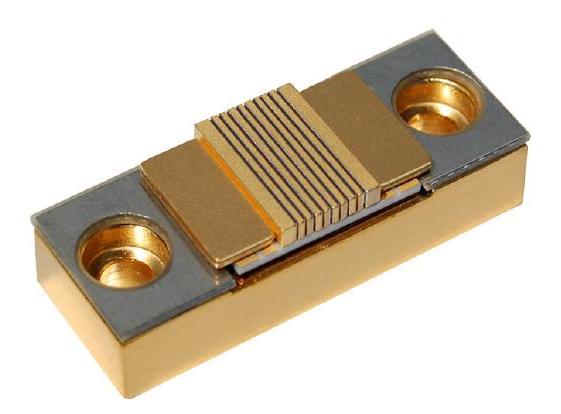
Northrop Grumman Cutting Edge Optronics has developed a family of arrays for high-power QCW operation. These
arrays are built using CTE-matched heat sinks and hard solder in order to maximize the reliability of the devices.
A summary of a recent life test is presented in order to quantify the reliability of QCW arrays and associated laser gain
modules. A statistical analysis of the raw lifetime data is presented in order to quantify the data in such a way that is
useful for laser system designers.
The life tests demonstrate the high level of reliability of these arrays in a number of operating regimes. For single-bar
arrays, a MTTF of 19.8 billion shots is predicted. For four-bar samples, a MTTF of 14.6 billion shots is predicted. In
addition, data representing a large pump source is analyzed and shown to have an expected lifetime of 13.5 billion shots.
This corresponds to an expected operational lifetime of greater than ten thousand hours at repetition rates less than 370
Hz.
January 12, 2010
Reliability of High-Power QCW Arrays1
Ryan Feeler2, Jeremy Junghans, Jennifer Remley, Don Schnurbusch, and Ed Stephens
Northrop Grumman Cutting Edge Optronics, 20 Point West Blvd., St. Charles, MO USA 63301
1. INTRODUCTION
Diode-pumped solid-state (DPSS) lasers are used in a wide range of industrial, scientific, and military applications. The
applications include ablation, cutting, welding, range finding, bathymetry, and numerous others. Each of these
applications requires different qualities from a DPSS laser, with wide variations in pulse energy, duration, and beam
quality within the application space.
Historically, high-energy pulsed DPSS lasers have been obtained by Q-switching a laser medium, such as an Nd:YAG
rod or slab, that is pumped by continuous-wave (CW) laser diode arrays. However there are many benefits that can be
obtained by using a pumping scheme that utilizes quasi-continuous wave (or QCW) laser diode arrays. QCW laser diode
bars can operate at higher peak powers than their CW counterparts. In addition, multiple high-peak-power QCW bars
can be packaged into the same area as a single CW bar, due to the lower average waste heat of each bar running in QCW
mode. These factors combine to enable compact diode pumps with very high peak powers when operating in QCW
mode. In addition, QCW pumping can reduce the heat load in the laser gain medium, which tends to reduce thermal
lensing effects and improve laser beam quality.
The main drawback of QCW pumping schemes in the past has been the short lifetimes of the laser diode arrays. CW
laser diode arrays with lifetimes in excess of 10,000 hours are readily available in the industry today. This corresponds
to 416 days of continuous operation and is viewed as the benchmark for reliability that all DPSS systems must meet or
exceed. QCW laser diode arrays operating at power levels that make them attractive to laser designers (typically 2-3x
their CW counterparts) have historically suffered from sudden bar failures due to catastrophic optical damage (COD) of
the laser diode output facet. In order to make QCW laser diode arrays attractive to laser system designers and
manufacturers, COD must be suppressed and lifetimes greater than 10,000 hours must be demonstrated.
Northrop Grumman Cutting Edge Optronics (NGCEO) has manufactured CW and QCW laser diode bars and arrays for
over a decade. Recent improvements in array packaging and bar manufacturing processes have enabled NGCEO to
produce QCW laser diode arrays with lifetimes greater than what is required by industrial applications.
2. HIGH-POWER QCW ARRAYS
NGCEO has developed a family of high-power QCW arrays for use in applications which require long lifetimes (over
one year of continuous operation). These arrays utilize the same technology that was developed for high-power military
and industrial applications that are subject to harsh operating environments[1]. Two things are required to achieve long
lifetimes in QCW arrays: (1) a robust laser diode bar designed for QCW operation and (2) array packaging based on
hard solder. These two items combine to create arrays with high reliability.
2.1 QCW Laser Diode Bar
NGCEO utilizes an 83% fill factor bar for the majority of QCW applications. This bar is specifically designed for highpower
operation and is used in applications with output powers ranging from 60-230 Watts/bar at 808 nm. Higher
output powers are available at higher wavelengths. Power and efficiency as a function of current for a typical 808 nm
bar are shown in Figure 1. This data was obtained at 20 Hz, 150 Es on a conductively-cooled mount.
1 This paper was originally published in the proceedings of SPIE 7583: High Power Diode Laser Technology and
Applications XIII (January 2010). Published with permission of SPIE.
2 ryan.feeler@ngc.com, (636) 916-4900, http://www.as.northropgrumman.com/businessventures/ceolaser/index.html
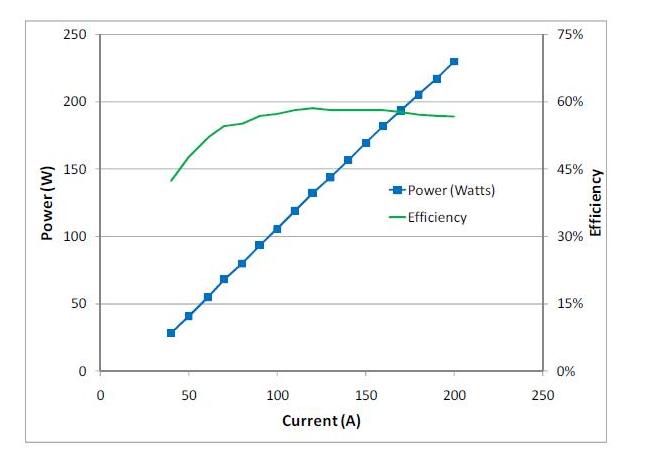
Figure 1. Power and efficiency as a function of current for NGCEO's high-power QCW laser diode bar.
2.2 Hard Solder Packaging
Some of the major historical limitations to QCW array lifetimes have been the processes and materials used to package
the laser diode bars. Historically, soft solders (e.g. indium) were used in multiple locations in the array. Arrays built
using soft solders are prone to packaging induced failures from solder creep. Advances in packaging methodologies at
NGCEO have enabled the creation of the Golden BulletTM product line. Golden BulletsTM utilize eutectic AuSn solder
and CTE-matched heatsinks to create a package that is less prone to solder creep, and therefore offers much higher
reliability and product lifetimes.
A generic representation of the assembly method used for these devices is shown in Figure 2. Diode bars are initially
soldered to CuW heatsinks with AuSn solder using a proprietary process designed to generate low-stress bonds and lowsmile
bars. The resulting part is called a Mounted Bar Assembly (MBA). The MBAs can be individually tested and
binned for wavelength based upon the requirements of the application. The MBAs are then soldered together and
attached to a BeO backplane and n- and p-side contacts in a secondary operation, resulting in a Golden BulletTM
package. The Golden BulletsTM can then be attached to a wide variety of standard and custom heatsinks based upon the
customer's needs. They are suitable for use in water- and conductively-cooled applications.

Figure 2. Overview of Golden BulletTM assembly process.
3. LIFE TEST RESULTS
Single- and four-bar Golden BulletsTM were selected for this life test. Three different wafer lots were used to create the
samples (all three were used in both single- and four-bar Golden BulletsTM). A summary of the relevant test parameters
is included in Table 1. The test parameters were selected based on typical Nd:YAG DPSSL pumping scenarios.
Table 1. Summary of life test parameters.
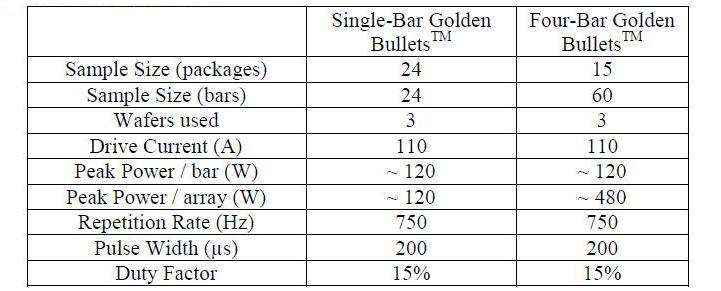
The samples were soldered onto water-cooled heat exchangers and characterized on NGCEO's NIST-traceable laser
diode test station. They were then loaded into NGCEO's automated life test station – the devices were not burned in
prior to this test. The drive current was supplied to the samples by an NGCEO eDrive laser controller. The output
power of each device was measured every 90 minutes (approximately 4 million shots) by the life test station and saved
to a log file. The life test results are shown in Figure 3. Three of the 15 four-bar samples experienced infant mortalities
– all three failed at less than 8 million shots – and are excluded from the data. Therefore the data represents the expected
performance of devices shipped by NGCEO, since infant mortalities in production arrays are screened out by an
established burn-in process.
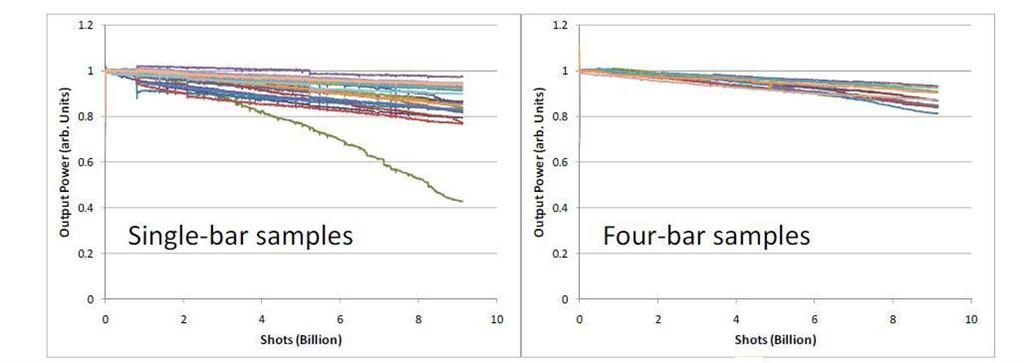
Figure 3. Life test data for single-bar (top) and four-bar (bottom) Golden BulletsTM operating at 110 A.
As of late December, 2009, the samples had accumulated approximately 9.1 billion shots. There had been no COD
failures of any diode bars (excluding infant mortalities), and all samples are aging gradually. The distribution of
degradation rates is much tighter for the four-bar samples. This is expected since those samples already represent an
average of four bars, so bars with high and low degradation rates tend to cancel each other out.
4. RELIABILITY ANALYSIS
There are several definitions of device failure that are common in the laser diode industry. For the purpose of this
analysis, failure is defined as 20% power degradation at a constant drive current. Since the vast majority of these
samples had not failed by the time of paper submission, an acceptable means of extrapolation had to be defined. Most of
the samples are experiencing a degradation that is approximately linear with time. Therefore, the degradation rate during
the last 3 billion shots was calculated and used to extrapolate the data for each sample to a time to failure (TTF).
The TTF data was analyzed using statistical analysis software (MinitabTM). The data was plotted against four
distributions (Weibull, Lognormal base e, Exponential, and Normal) in order to determine which distribution had the
best fit with the experimental data, and the Lognormal base e distribution was selected for both data sets (single- and
four-bar). The resulting reliability plots are shown in Figure 4 and include curves for the 95% confidence interval. The
calculated MTTF values are 19.8 Billion shots for the single-bar samples and 14.6 Billion shots for the 4-bar samples.
NGCEO is continuing the life test in order to see if the actual failure times correlate with the extrapolated data presented
here.
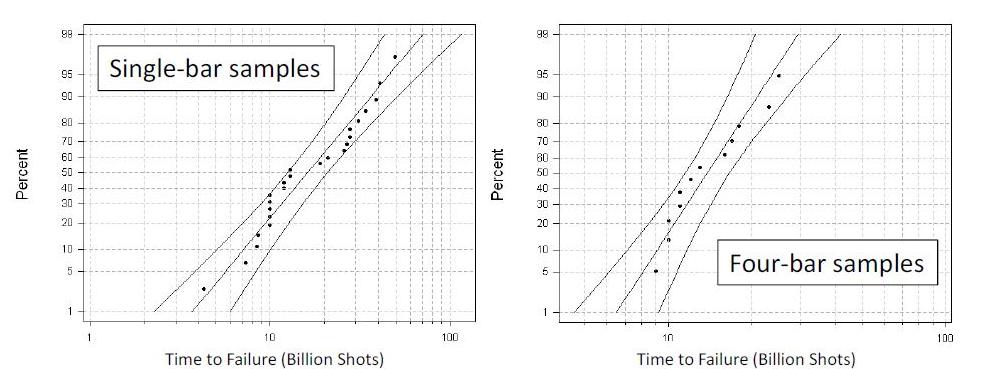
Figure 4. Reliability plots for single-bar (top) and four-bar (bottom) QCW Golden BulletsTM operating at 110 A.
5. POWERPULSETM LASER GAIN MODULES
NGCEO has leveraged its high-power QCW diode array technology and its existing laser gain module product line to
create the PowerPULSETM series of laser gain modules. These gain modules incorporate long-life QCW arrays in a
module with a laser rod (Nd:YAG, Nd:YLF, or Nd:YVO4) and are capable of generating pulse energies greater than 1
Joule. An example PowerPULSETM gain module is shown in Figure 5.
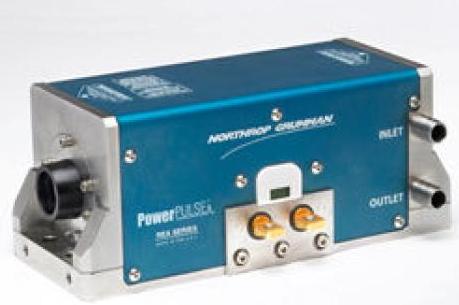
Figure 5. PowerPULSETM laser gain module available from NGCEO. These gain modules contain long-life
QCW laser diode arrays and a laser rod.
The versions of the PowerPULSETM module that are used in very high-energy systems contain multiple heat exchangers,
each of which contains several multi-bar QCW arrays similar to the four-bar samples in the above life test. These
modules typically contain between 20 and 200 QCW laser diode bars. Therefore it is of interest to analyze the
degradation of the ensemble of four-bar arrays presented above as a single entity, since that is representative of what can
be expected of the laser diode arrays in a single PowerPULSETM gain module. This is accomplished by summing the
individual power measurements at each point in Figure 3 and then extrapolating the results. This data is shown in Figure 6.
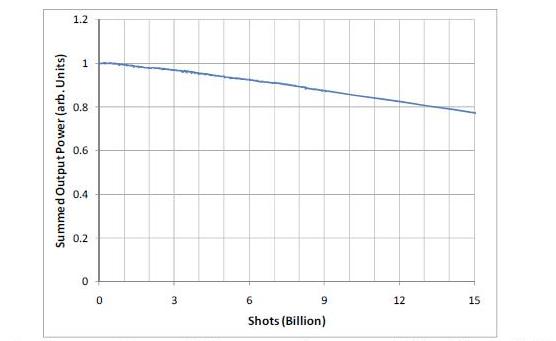
Figure 6. Total measured output power from all 4-bar samples presented in Figure 3. Data to 9.1 billion shots is
measured, data beyond 9.1 billion shots is extrapolated.
The data presented in Figure 6 indicates that the QCW arrays in a typical PowerPULSETM gain module will fail after
approximately 13.5 billion shots if 20% degradation (with zero current turn-up) is used as the failure criteria. It is worth
noting, however, that these arrays are designed to reliably operate at considerably higher output powers. Therefore the
current could be increased as the arrays degrade in order to obtain longer lifetimes.
A plot of operational lifetime versus repetition rate is shown in Figure 7. This data is based on a product lifetime of 13.5
billion shots as shown in Figure 6 for the analyzed ensemble of four-bar Golden BulletsTM, and assumes continuous
operation (24 hours/day, seven days/week). Therefore this graph serves as a guideline of what is expected from the
PowerPULSETM line of laser gain modules. For example, at a repetition rate of 100 Hz, the data predicts an operational
lifetime of ~ 1500 days. Lifetimes greater than 416 days (10,000 hours) are predicted for all repetition rates < 370 Hz.
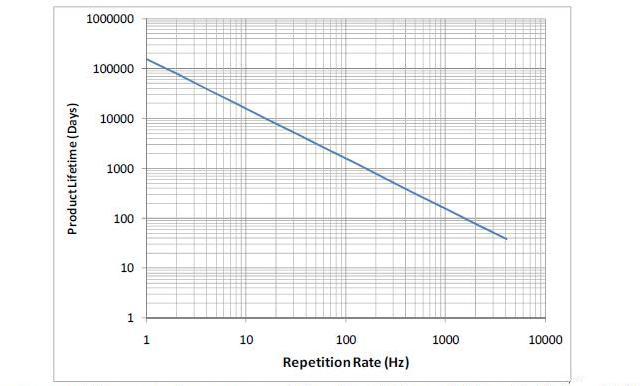
Figure 7. Lifetime versus repetition rate for an ensemble of multi-bar Golden BulletTM QCW laser diode arrays.
This is representative of what is expected of the PowerPULSETM laser gain module product line.
6. CONCLUSION
Northrop Grumman Cutting Edge Optronics has developed a line of QCW laser diode arrays based on its Golden
BulletTM package and high-power QCW laser diode bars. A representative sample of this product line has been life
tested and shown to have long lifetimes (MTTF values of 19.8 billion and 14.6 billion shots for single- and four-bar
samples, respectively). There were no sudden bar failures during the course of this life test – all samples have degraded
gradually.
NGCEO has leveraged the success of its long-life QCW laser diode arrays to create a line of QCW-pumped laser gain
modules (the PowerPULSETM product line). These gain modules can be used to create lasers with pulse energies greater
than one Joule. Most importantly, they surpass the industrial standard of 10,000 hours of operating lifetime for all
repetition rates < 370 Hz. Therefore the advantages that can be obtained by pulse pumping DPSS lasers are achievable
without sacrificing product lifetime.
REFERENCES
[1] Feeler, R., Junghans, J., Stephens, E., "High-power QCW arrays for operation over wide temperature extremes,"
Proceedings of SPIE Vol. 7198, 71981F (2009).
Our Products
 |
Laser Diode Arrays
CEO® offers a full line of conductively cooled, water cooled or microchannel cooled laser
diodes and stacks. Choose from our wide range of standard product offerings including Golden
Bullet arrays for long pulse (>500 Es) applications. Wavelengths from 780 – 1550 nm are
available.
|
|

|
CW Pumped Laser Modules
Our range of diode modules are an ideal 'pump engine' solution for OEM manufacturers of Diode
Pumped Solid State (DPSS) lasers. They are available with a variety of gain media options
(Nd:YAG, Nd:YLF, Nd:YVO4 etc.). Output powers ranging from 20 W (TEMoo) to 800 W
(multi mode) are available.
|
|

|
QCW Pumped Laser Modules
For high energy pulsed laser applications, CEO offers the PowerPULSE family of modules to
deliver output energies up to 4 J per pulse and small signal gain in excess of 600. CTE matched,
'hard solder' laser diode packaging technology ensures long operating lifetimes.
|
|

|
Electronics & Support Equipment
Choose from CEO’s complete line of proven and versatile OEM high powered diode drivers and
laser system controllers along with all the support equipment needed to operate high power CW
and QCW pump modules or other diode-based laser systems.
|
|

|
Industrial Laser Systems
CEO offers industrial laser systems for micro-machining, marking, cutting, drilling, welding,
soldering, and other industrial uses. These lasers utilize long-life diode pump sources to enable
long laser lifetimes. Custom lasers can be built to a wide range of specifications.
|
|

|
Military & Custom Lasers
CEO® offers complete custom laser design engineering and manufacturing services of diode
pumped solid state lasers (DPSS), laser diode arrays and modules for military, aerospace and
industrial OEM laser applications. CEO specializes in engineering systems that are required to
operate in harsh rugged environments including military & civilian helicopters, fixed wing
aircraft, ground vehicles, and submerged towed bodies.
|
Contact Us
Telephone: 636.916.4900
Fax: 636.916.4994
st-ceolaser-info@ngc.com
20 Point West Boulevard, St. Charles, MO (USA), 63301
http://www.as.northropgrumman.com/businessventures/ceolaser/index.html
美国CEO公司在中国的经销商--科艺仪器公司,为中国客户提供本地的销售和售后服务。科艺仪器在中国大陆及香港、台湾、新加坡等地均设有办事处或分公司,都有经验丰富的销售人员随时为您提供优质的服务,包括产品选择,价格咨询,产品递送和售后服务等。科艺仪器公司网址http://www.anpico.com,欢迎访问或拨打400-886-0017来电垂询。